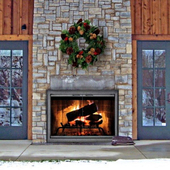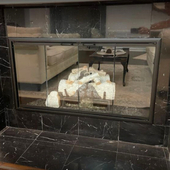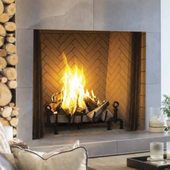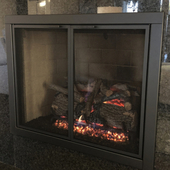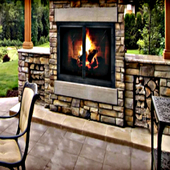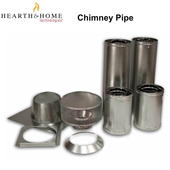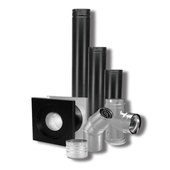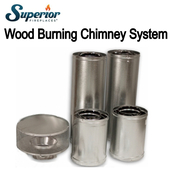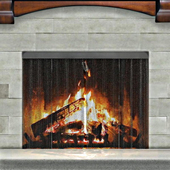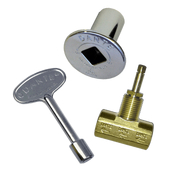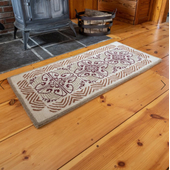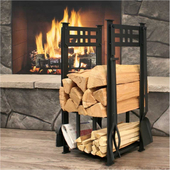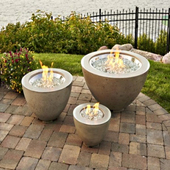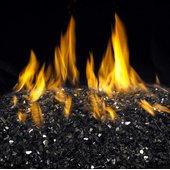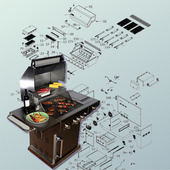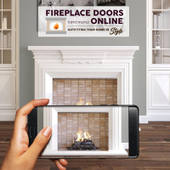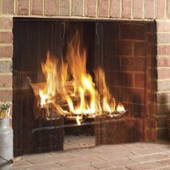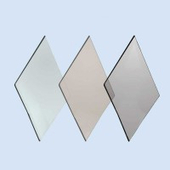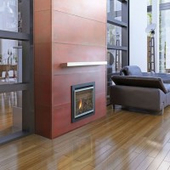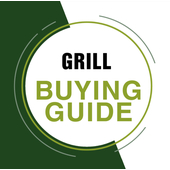Round Termination Cap with Storm Collar for SL1100 Series Chimney Pipe | TR11
Hearth & Home Technologies Round Termination Cap with Storm Collar includes everything needed to quickly and easily finish the venting installation of a wood-burning fireplace. This direct vent termination cap has a rugged design that is built to offer weather protection for the SL1100 Series chimney pipe. The included storm collar prevents the elements from entering the venting system, protecting your home from water damage.
Features:
A Round Termination Cap with a Storm Collar is a critical component used in the construction of chimneys and venting systems for various heating appliances. This combination of components is designed to ensure the proper functioning and safety of the venting system. Let's break down what each of these components does:
- Round Termination Cap: This is a device that serves as the uppermost part of a chimney or vent pipe. It's designed to provide several essential functions:
- Weather Protection: The termination cap prevents rain, snow, and debris from entering the chimney or vent. This helps keep the interior dry and free from any blockages that could disrupt the airflow.
- Animal and Pest Prevention: It also acts as a barrier to keep birds, rodents, and other animals from entering the chimney, which can be dangerous and create obstructions.
- Downdraft Prevention: The cap helps prevent downdrafts, where wind can blow down the chimney, potentially causing smoke or toxic gases to enter the living space.
- Improved Draft: Properly designed caps can improve the draft of the chimney, helping the heating appliance operate efficiently.
- Storm Collar: The storm collar is a metal collar that fits around the chimney pipe just above the termination cap. Its primary purpose is to create a weatherproof seal. Here's how it works:
- Waterproof Seal: The storm collar prevents water from running down the exterior of the chimney pipe and entering the interior. This is crucial for maintaining the integrity of the venting system and preventing water damage.
- Tight Seal: It helps maintain a tight seal around the chimney pipe, even in adverse weather conditions, ensuring that no moisture can penetrate the structure.
These components are commonly used in a variety of heating systems, including wood stoves, gas fireplaces, and pellet stoves. When installing or replacing a termination cap with a storm collar, it's essential to ensure that they are compatible with your specific chimney or venting system. The correct sizing and proper installation are crucial for safety and efficient operation.
Specifications:
- Material: Aluminized Steel
- Type: Termination Cap
- Vent Pipe Inner Diameter: 11"
- Vent Pipe Outer Diameter: 13"
- Includes: Termination Cap | Storm Collar
- Use: Ducting and Venting
- Designed for through-the-ceiling vertical termination
- Quickly and easily complete a wood-burning appliance with a vertical venting system
- The included storm collar prevents the outside elements from entering the venting system
- UL-listed - proven effective in protecting venting components and ensuring safe exhaust flow
- Promised to add extra curb appeal to your home without hindering fireplace functionality
Downloads
Choosing The Perfect Venting System for Your Fireplace
To ensure security, effectiveness, and usefulness, it is crucial to select the ideal venting system for your fireplace. There are several factors to consider when selecting a venting system, including the type of fireplace, fuel source, local building codes, and your personal preferences. Here's a step-by-step guide to help you make the right choice:
Determine the Type of Fireplace:
- Wood-Burning Fireplace: If you have a traditional wood-burning fireplace, you'll need a chimney or venting system designed to handle the combustion byproducts and smoke.
- Gas Fireplace: Gas fireplaces can be vented through either a direct vent or a ventless (vent-free) system. Your choice will depend on local regulations and your heating needs.
Understand Venting Options:
- Chimney: A traditional masonry or metal chimney is suitable for wood-burning fireplaces. Ensure it is in good condition and meets local codes.
- Direct Vent: This system is commonly used for gas fireplaces. It has a sealed combustion chamber and draws fresh air from outside for combustion while expelling exhaust gases outside through a dedicated vent pipe.
- Ventless (Vent-Free): Ventless gas fireplaces don't require a chimney or external venting. They burn gas cleanly and release heat and moisture into the room. However, they are subject to strict regulations in some areas due to air quality concerns.
Check Local Building Codes:
- Before making a decision, check local building codes and regulations. Some areas have strict requirements for venting systems to ensure safety and air quality. Compliance with these codes is crucial.
Consider Efficiency:
- Choose a venting system that maximizes energy efficiency. Direct vent systems are more efficient than traditional chimneys because they minimize heat loss.
Safety Considerations:
- Safety should be a top priority. Ensure that the venting system is correctly installed and maintained to prevent carbon monoxide leaks and other hazards.
Aesthetics and Design:
- The venting system should complement your home's design and aesthetics. It should be as unobtrusive as possible while still performing its function.
Professional Installation:
- It's strongly recommended to have your venting system installed by a qualified professional who is familiar with local codes and regulations.
Maintenance:
- Regular maintenance is essential to keep your venting system working efficiently and safely. Schedule annual inspections and cleanings, especially for wood-burning chimneys.
Budget:
- Consider your budget for both the initial installation and ongoing maintenance. While ventless systems may be cheaper to install initially, they may have higher operating costs due to increased gas consumption.
Environmental Impact:
- If you're concerned about environmental impact, consider the emissions associated with your chosen venting system. Wood-burning fireplaces, for example, can release particulate matter and other pollutants into the air.
Ultimately, your individual circumstances, such as the sort of fireplace you have, your local laws, and your own preferences for aesthetics and efficiency, will determine the ideal venting system for your fireplace. You can make a more informed choice by speaking with our experts at fireplace doors online.
A Comprehensive Guide to Buying a Fireplace Venting System
A fireplace venting system is an essential part of your fireplace that makes sure that smoke and combustion byproducts are securely removed from your home while providing a supply of fresh air for burning. Whether you're installing a new fireplace or upgrading an existing one, this comprehensive buyer's guide will help you understand the various venting options and make an informed decision.
1. Types of Fireplace Venting Systems:
There are three main types of fireplace venting systems:
- Chimney Venting: Traditional masonry fireplaces typically have a brick or stone chimney. They rely on natural convection to draw air in and expel smoke out through the chimney. This type of venting is suitable for wood-burning fireplaces.
- Direct Venting: This is a sealed system that draws combustion air from the outside and expels exhaust gases through a vent pipe. Direct vent fireplaces are highly efficient and can be used with various fuel types, including gas and propane.
- Ventless or Vent-Free Venting: These fireplaces do not require a venting system, as they are designed to burn fuel cleanly enough that the combustion byproducts can be safely released into the room. They are typically gas-powered and can be installed almost anywhere.
2. Choosing the Right Type:
- Consider Your Fuel Type: Determine whether you want a wood-burning, gas, or electric fireplace. Your fuel choice will influence the type of venting system you need.
- Efficiency and Convenience: Direct vent and ventless fireplaces are typically more energy-efficient and easier to install than traditional chimneys. Consider your preferences for convenience and energy efficiency.
3. Sizing and Location:
- Calculate Heating Needs: Determine the heating capacity you need based on the size of the room or area you want to heat. This will help you choose an appropriately sized fireplace and venting system.
- Location: Decide where you want to install your fireplace. The location may impact the type of venting system you can use and the venting route.
4. Venting Materials:
- Chimney Materials: If you're using a traditional chimney, consider the type of materials you want for its construction, such as brick, stone, or metal flue liners.
- Vent Pipe Material: For direct vent fireplaces, the vent pipe is typically made of aluminum or stainless steel. Ensure the materials are suitable for your fuel type and meet local building codes.
5. Installation and Safety:
- Professional Installation: Proper installation is crucial for safety and performance. Hire a certified technician or contractor experienced in fireplace venting systems.
- Clearances: Ensure proper clearances to combustibles are maintained as per the manufacturer's guidelines and local building codes.
6. Venting Accessories:
- Termination Caps: These protect the vent opening from weather and pests.
- Chimney Liners: If you have a masonry chimney, consider installing a stainless steel liner to improve efficiency and safety.
7. Maintenance and Cleaning:
- Regular Inspections: Schedule regular inspections and cleaning to ensure your venting system is functioning correctly and free from debris or blockages.
8. Legal and Safety Considerations:
- Local Codes and Regulations: Check with your local authorities to ensure compliance with building codes and regulations regarding fireplace venting.
- Carbon Monoxide Detectors: Install carbon monoxide detectors in your home, especially if you have a gas fireplace.
9. Budget Considerations:
- Initial Cost: Consider both the upfront cost of the fireplace and venting system, as well as the ongoing operating costs (fuel, maintenance, etc.).
10. Aesthetics:
- Design and Style: Choose a venting system that complements your home's aesthetic and blends well with your interior design.
Remember that safety should always be your top priority when selecting and installing a fireplace venting system. Consult with professionals and follow manufacturer guidelines and local regulations to ensure a safe and efficient installation.
Hearth & Home Technologies LLC LIMITED LIFETIME WARRANTY
Hearth & Home Technologies LLC (“HHT”) extends the following warranty for HHT gas, wood, pellet and electric hearth appliances (each a “Product” and collectively, the “Product(s)”) and certain component parts set forth in the complete downloadable PDF in the product description(“Component Part(s)”) that are purchased from a HHT authorized dealer or distributor.
WARRANTY COVERAGE: HHT warrants that the Products and their Component Parts will be free from defects in materials and workmanship for the applicable period of Warranty coverage set forth in the table found in the downloadable PDF in the product description (“Warranty Period”). If a Product or Component Parts are found to be defective in materials or workmanship during the applicable Warranty Period, HHT will, at its option, repair the applicable Component Part(s), replace the applicable Component Part(s), or refund the purchase price of the applicable Product(s). The maximum amount recoverable under this Warranty is limited to the purchase price of the Product.
This Warranty is transferable from the original purchaser to subsequent owners, but the Warranty Period will not be extended in duration or expanded in coverage for any such transfer. This Warranty is subject to conditions, exclusions, and limitations as described below.
WARRANTY PERIOD: Warranty coverage begins at the date of installation. In the case of new home constructions, Warranty coverage begins on the date of first occupancy of the dwelling or six months after the sale of the Product(s) by an independent, authorized HHT dealer or distributor, whichever occurs earlier. However, the Warranty coverage shall commence no later than 24 months following the date of Product shipment from HHT, regardless of the installation or occupancy date.
The term “Lifetime” in the downloadable PDF in the product description is defined as: 20 years from the beginning date of warranty coverage for gas appliances, 10 years from the beginning date of warranty coverage for wood and pellet appliances, and 5 years from the beginning of warranty coverage for standalone gas log sets. These time periods reflect the minimum expected useful lives of the designated Component Parts under normal operating conditions.
No posts found
Click on the Add New button below to submit a question about this product. Please ONLY submit product questions. For all other inquiries, please contact us at 1-888-986-1535.












